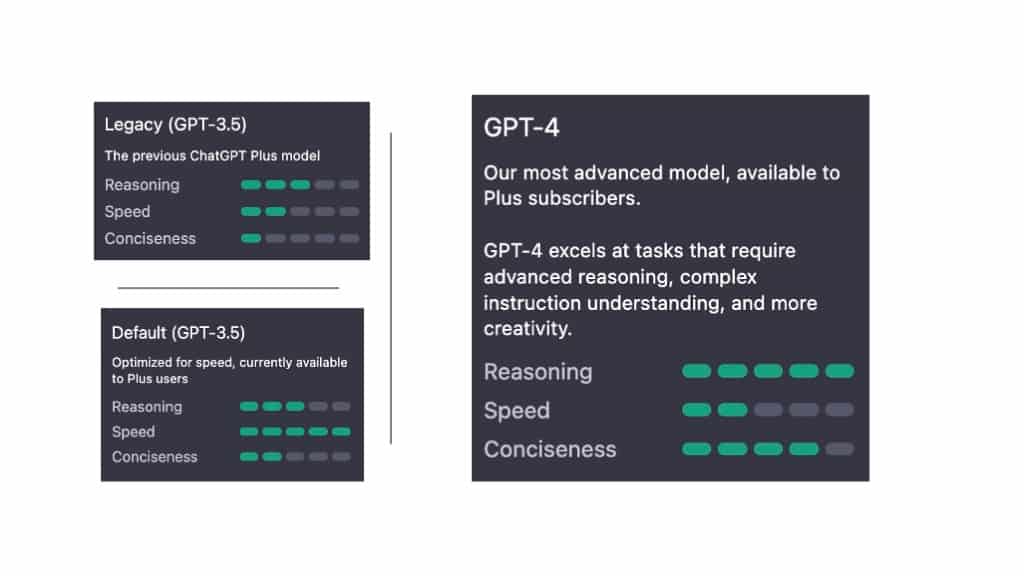OpenAI’s ChatGPT-4, a state-of-the-art language model that has surpassed its predecessors in terms of capability andperformance. In this blog article, we will dive into the remarkable features of ChatGPT-4, explore its practical applications, and discuss how it is shaping the future of AI-powered communication.
Comparison with ChatGPT 3.5
Let’s quickly look at the differences between them first through this infographic below;
 So what’s new with ChatGPT 4?
So what’s new with ChatGPT 4?
At its core, ChatGPT-4 is built on the GPT-4 architecture, which has revolutionized the field of natural language processing. With billions of parameters, this model can understand, generate, and process human-like text with incredible accuracy. Some key advancements that set ChatGPT-4 apart from its predecessors include:
Enhanced Contextual Understanding: ChatGPT-4 has the ability to grasp context and retain information throughout a conversation, resulting in more coherent and relevant responses. This advancement allows it to engage in longer, more meaningful conversations with users.
Improved Language Generation: The model’s language generation capabilities have been refined, enabling it to create text that is not only coherent but also engaging and creative. From composing poems and stories to generating research summaries, ChatGPT-4 can adapt its writing style to match the desired output.
Multilingual Support: ChatGPT-4 has expanded its language repertoire, now supporting multiple languages beyond English. This increased versatility allows for more users around the world to benefit from its capabilities.
Advanced Sentiment Analysis: The model’s ability to analyze and understand sentiment has been significantly improved, enabling it to respond appropriately to user emotions and generate text that is sensitive to the context.
Practical Applications of ChatGPT-4
The incredible capabilities of ChatGPT-4 have opened up a wealth of opportunities across various industries. Some of the most prominent applications include:
Customer Support: ChatGPT-4 can efficiently handle customer queries and complaints, providing quick and accurate responses. This can help businesses save time and resources while ensuring customer satisfaction.
Content Creation: From blog articles to social media posts, ChatGPT-4 can generate high-quality, engaging content tailored to specific target audiences.
Language Translation: With its multilingual capabilities, ChatGPT-4 can serve as a powerful translation tool, bridging language barriers and facilitating global communication.
Tutoring and Education: The model can be used to provide personalized tutoring in various subjects, as well as generate educational content and learning materials.
Gaming and Entertainment: ChatGPT-4 can be integrated into video games and other interactive experiences, creating immersive and engaging dialogues for users.
The Future of AI-Powered Communication
As ChatGPT-4 continues to push the boundaries of AI language capabilities, it is paving the way for more advanced and intuitive human-machine interactions. As the technology evolves, we can expect to see even more sophisticated language models that can handle complex tasks, understand and respond to human emotions, and even generate content that rivals human creativity.
Conclusion
ChatGPT-4 is a remarkable testament to the power and potential of artificial intelligence. Its capabilities have not only revolutionized natural language processing but also opened up a world of possibilities across various industries. As we continue to explore and refine the potential of AI-powered communication, there is no doubt that models like ChatGPT-4 will play a pivotal role in shaping the future of human-machine interaction.
At the present moment, ChatGPT engine is only available for those who subscribe, ie ChatGPT Plus subscribers only. You can join the waitlist to use it at some point, hopefully sooner than later.
For more information, check out OpenAI’s ChatGPT 4 release page here.


